N.T. Wright; Considering N.T. Wright; N.T. Wright at Laity Lodge; Simply Christian
How Lent Can Make a Difference
in Your Relationship with God
by Rev. Dr. Mark D. Roberts
Copyright © 2005, 2006, 2007, 2009 by Mark D. Roberts
Note: You may download this resource at no cost, for personal use or for use in a Christian ministry, as long as you are not publishing it for sale. All I ask is that you give credit where credit is due. For all other uses, please contact me at mark@markdroberts.com. Thank you.
How Lent Can Make a Difference in Your Relationship with God
Part 1 of series: How Lent Can Make a Difference in Your Relationship with God (2009)
Permalink for this post / Permalink for this series
Preface
For the past several years, I have followed my posts on Ash Wednesday with a discussion of Lent. I am doing the same this year. Some of what you read in this mini-series will repeat what I've done before (with needed edits). Some of what you read will be new. My point is to help my readers understand Lent. But, more importantly, I want to help people grow in their relationship with God through observing Lent in appropriate ways.
Introduction to Lent
Growing up as an evangelical Christian, I experienced Lent as little more than a joke. "What are you giving up for Lent?" my friends would ask. "Homework," I'd say with a smirk, or "Obeying my parents." Lent was one of those peculiar practices demanded of Roman Catholics - another great reason to be Protestant, I figured. It never even occurred to me that Lent was something I might actually be interested in, or benefit from, or decide to keep, or come to value as a way of getting to know God better.
In the last fifteen years I've discovered that Lent is in fact recognized by millions of Protestant Christians, in addition to Catholic and Orthodox believers. (The Eastern Orthodox Lent is longer than the Catholic or Protestant Lent, and it begins before Ash Wednesday.) Lent (the word comes from the Middle English word for "spring") is a six-week season in the Christian year prior to Easter. (Technically, Lent comprises the 40 days before Easter, not counting the Sundays, or 46 days in total.)
In the ancient church, Lent was a time for new converts to be instructed for baptism and for believers caught in sin to focus on repentance. In time, all Christians came to see Lent as a season to be reminded of their need for penitence and to prepare spiritually for the celebration of Easter. Part of this preparation involved the Lenten "fast," giving up something special during the six weeks of Lent (but not on Sundays, in some traditions.)
Historically, many Protestants rejected the practice of Lent, pointing out, truly, that it was nowhere required in Scripture. Some of these Protestants were also the ones who refused to celebrate Christmas, by the way. They wanted to avoid some of the excessive aspects of Catholic penitence that tended to obscure the gospel of grace. These Protestants saw Lent, at best, as something completely optional for believers, and, at worst, as a superfluous Catholic practice that true believers should avoid altogether.
A Pastoral Word: Let me note, at this point, that if you think of Lent as a season to earn God's favor by your good intentions or good works, then you've got a theological problem. God's grace has been fully given to us in Christ. We can't earn it by doing extra things or by giving up certain other things in fasting. If you see Lent as a time to make yourself more worthy for celebrating Good Friday and Easter, then perhaps you shouldn't keep the season until you've grown in your understanding of grace. If, on the contrary, you see Lent as a time to grow more deeply in God's grace, then you're approaching Lent from a proper perspective.
Some segments of Protestantism did continue to recognize a season of preparation for Easter, however. Their emphasis was not so much on penitence and fasting as on intentional devotion to God. Protestant churches sometimes added special Lenten Bible studies or prayer meetings so that their members would be primed for a deeper experience of Good Friday and Easter. Lent was a season to do something extra for God, not to give something up.
 After ignoring Lent for the majority of my life, I've paid more attention to it during the last two decades. Sometimes I've given up something, like watching television or eating sweets, in order to devote more time to Bible study and prayer. (The television fast was especially tough because I love watching March Madness, the NCAA basketball tournament, on TV.) Sometimes I've added extra devotional reading to my regular spiritual disciplines. I can't claim to have had any mystical experiences during Lent, but I have found that fasting from something has helped me focus on God. It has also helped me to look ahead to Good Friday and Easter, thus appreciating more deeply the meaning of the cross and the victory of the resurrection. Before I began honoring Lent, Good Friday and Easter always seemed to rush by before I could give them the attention they deserved. Now I find myself much more ready to meditate upon the depth of Christ's sacrifice and to celebrate his victory over sin and death on Easter. After ignoring Lent for the majority of my life, I've paid more attention to it during the last two decades. Sometimes I've given up something, like watching television or eating sweets, in order to devote more time to Bible study and prayer. (The television fast was especially tough because I love watching March Madness, the NCAA basketball tournament, on TV.) Sometimes I've added extra devotional reading to my regular spiritual disciplines. I can't claim to have had any mystical experiences during Lent, but I have found that fasting from something has helped me focus on God. It has also helped me to look ahead to Good Friday and Easter, thus appreciating more deeply the meaning of the cross and the victory of the resurrection. Before I began honoring Lent, Good Friday and Easter always seemed to rush by before I could give them the attention they deserved. Now I find myself much more ready to meditate upon the depth of Christ's sacrifice and to celebrate his victory over sin and death on Easter.
Let me be very clear: Lent is not a requirement for Christians. Dallas Willard has said that if a certain spiritual discipline helps you grow in God's grace, then by all means do it. But if it doesn't, don't feel like you must do it. I'd say the same about Lent. If it helps you prepare for a deeper celebration of Good Friday and Easter, if it allows you to grow in God's grace, then by all means keep it. If Lent isn't your cup of tea, then don't feel obligated to keep it. You should realize, however, that millions of Christians – Catholic, Orthodox, Protestant, and Independent – have found that recognizing the season of Lent enriches our worship and deepens our faith in God.
In my next post in this series I'll consider some of the symbolism of Lent, and suggest some possible Lenten practices to help you keep the season.
Do You Have to Give Up Something for Lent?
Part 2 of series: How Lent Can Make a Difference in Your Relationship with God (2009)
Permalink for this post / Permalink for this series
 I grew up hearing about Catholics who had to fast during the season of Lent. No meat on Fridays, only fish. This, you must understand, was a costly sacrifice in the cafeteria of Glenoaks Elementary School! The fact that my Catholic friends had to give up decent food in Lent always seemed to me to be one more good reason to be a Protestant. (Photo: I expect that the Lent Promo at the Luby's in Kerrville is much better than my elementary school's cafeteria rations.) I grew up hearing about Catholics who had to fast during the season of Lent. No meat on Fridays, only fish. This, you must understand, was a costly sacrifice in the cafeteria of Glenoaks Elementary School! The fact that my Catholic friends had to give up decent food in Lent always seemed to me to be one more good reason to be a Protestant. (Photo: I expect that the Lent Promo at the Luby's in Kerrville is much better than my elementary school's cafeteria rations.)
But, in the past fifteen years or so, I've sometimes decided to join my Catholic sisters and brothers in giving up something during Lent. This means, depending on how you count the days of Lent, fasting from something for about six weeks. (Officially in the Western world, Lent comprises the days from Ash Wednesday to Holy Saturday, the day before Easter. But many traditions do not count the Sundays during this period as belonging to Lent. Thus Lent covers 46 days, but only 40 days belong to the Lenten fast.)
People in my theological tradition (the Reformed tradition, pioneered by John Calvin) tend not to emphasize Lenten fasting. Partly this had to do with the conscious rejection of Roman Catholic practices that were not clearly based on Scripture. Lent is not prohibited in Scripture. But it isn't taught there either. One can be a faithful, biblical Christian and never recognize Lent. So, in days gone by, many Reformed folk and other Protestants who wanted to make the season before Easter special in some way, chose instead to add a spiritual discipline to their lives as a way of preparing for Easter. It's quite common today for churches that don't have midweek Bible studies, for example, to offer a Lenten Wednesday Evening Study or something like this. Special Lenten spiritual retreats are also increasingly common in Protestant in addition to Roman Catholic circles.
But fasting still plays a prominent role in Lenten practices of many Christians across the denominational and theological spectrum. Throughout church history there have been different kinds of Lenten fasts. Nobody, to my knowledge, expected anyone to give up all food for the whole season. In the Middle Ages it was common for Christians to give up certain sorts of food, like meat and/or dairy products, for example. This explains why, in my youth, Catholics abstained from meat on the Fridays of Lent. Many Catholics still observe this discipline. In the Eastern Orthodox Church, the Lenten fast is taken even more seriously than in the Roman Catholic church, with many Orthodox folk eating vegetarian meals during the season.
 In recent years I have sometimes given up something in Lent, perhaps chocolate or watching television. The latter was particularly hard because I enjoy college basketball, and March Madness (the NCAA bastketball tournament) always falls in the middle of Lent. This year I have decided to give up something I enjoy. I've also adopted an additional daily spiritual discipline. It don't think it would be appropriate for me to speak in detail about what I'm doing at this time. But I would like to share some reflections on what I've been learning through my version of a Lenten fast. In recent years I have sometimes given up something in Lent, perhaps chocolate or watching television. The latter was particularly hard because I enjoy college basketball, and March Madness (the NCAA bastketball tournament) always falls in the middle of Lent. This year I have decided to give up something I enjoy. I've also adopted an additional daily spiritual discipline. It don't think it would be appropriate for me to speak in detail about what I'm doing at this time. But I would like to share some reflections on what I've been learning through my version of a Lenten fast.
What I've Learned by Fasting During Lent
First, giving up something allows me to make a tangible sacrifice to the Lord. Although certain sacrifices are already present in my life, they're sort of "built in" at this point. I don't often experience giving up something for God on a daily basis. The act of sacrifice reminds me of my commitment to God and my desire to make him first in my life.
Second, by giving up something I usually enjoy on a daily basis, I have sometimes found myself yearning for that thing. Frankly, I've been tempted to give up my Lenten fast at times. I could easily argue that it's unnecessary (it is optional, after all) and certainly not taught in Scripture. But, though I don't think my effort at fasting makes God love or bless me more, I do think it raises my awareness of how much I depend on other things in life rather than the Lord. I see how easy it is for me to set up all sorts of little idols in my life. Fasting, in some way, helps me surrender my idols to God.
Third, when I give up something I like and then feel an unquenched desire for it, I'm reminded of my neediness as a person. And neediness, I believe, is at the heart of true spirituality. Jesus said:
"Blessed are the poor in spirit, for theirs is the kingdom of heaven. . . .
Blessed are those who hunger and thirst for righteousness, for they will be filled."
Matthew 5:3, 6
Of course feeling hungry for one of life's pleasures isn't quite the same as hungering and thirsting for righteousness. But when I feel my hunger, when I sense my neediness for some other thing, I can use this to get in touch with my hunger and need for God.
Fourth, as I continue with my Lenten fast, I find myself less eager for the thing I've given up. Ironically, this makes my fast easier. It's almost something I can take for granted, thus dulling the spiritual impact of the fast. But I'm also gratified to know that one of my little "idols" is being set aside in my heart, as I learn to depend more upon God. I'm experiencing a bit of freedom that makes me gladly thankful for God's grace at work in me.
Adding a Lenten Discipline
Instead of or in addition to fasting during Lent, you might add a spiritual exercise or discipline to your life. If your church sponsors a Lenten Bible study, you might choose to join this study. Or you may want to participate in some act of kindness, such as feeding people at a homeless shelter.
I like to add something that I can do every day. It needs to be realistic, given my nature and patterns of life. So, for example, it would be a bad idea if I decided to get up at 5:00 a.m. to pray for an hour each day of Lent. This would stretch me so far that I'd surely fail. But I could take on additional Bible reading. Some years I've read one chapter of a gospel each day of Lent, taking it in slowly and meditating upon it. Other years I've used a Lenten devotional to focus my thought.
If you have no idea what to do during Lent, let me suggest the following. Set aside some time of quiet to as the Lord what he wants you to do. See if the Spirit of God guides you to something. If nothing comes to mind, I'd recommend that you read a chapter of a gospel each day. If you start with Mark, you'll have time to read all of Mark plus all of one other gospel during Lent.
Perhaps some of my readers would like to suggest Lenten disciplines that they have tried in the past, and how they have experienced God's grace through these exercises.
So, as we enter the season of Lent, I am grateful for the saints who have gone before me, some of whome discovered the blessings of giving up something in Lent, while others grew in their faith by adding a Lenten discipline. No matter what you do during this Lenten season, I pray that God will draw us closer to him, and prepare us for a fresh experience of Good Friday and Easter. May God's peace be with You!
Writing on Lent, 2004 - 2008
How Lent Can Make a Difference in Your Relationship with God 
Part 1 of series: How Lent Can Make a Difference in Your Relationship with God 
Posted for Thursday, March 2, 2006
Newly edited version of previous post on Lent.
I have a blogging tradition for the day after Ash Wednesday, which is the second day of Lent (Ash Wednesday being the first). I put up a simple piece explaining the meaning and practices of Lent. This year's piece is similar to ones I've written before. If this is old hat for you, then come back tomorrow, because I'll be putting up a new reflection on the meaning of Lent.
I write about the meaning of Lent every year because this season of the church year is unfamiliar to many, including many Christians. But I write not only to explain, but also to invite you to experience God in a deeper and distinctive way. This, I believe, is one of the promises of Lent.
Growing up as an evangelical Christian, I experienced Lent as little more than a joke. "What are you giving up for Lent?" my friends would ask. "Homework," I'd say with a smirk, or "Obeying my parents." Lent was one of those peculiar practices demanded of Roman Catholics - another great reason to be Protestant, I figured. It never even occurred to me that Lent was something I might actually be interested in, or benefit from.
In the last fifteen years I've discovered that Lent is in fact recognized by millions of Protestant Christians, in addition to Catholic and Orthodox believers. (The Eastern Orthodox Lent is longer than the Catholic or Protestant Lent, and it begins before Ash Wednesday.) Lent (the word comes from the Middle English word for "spring") is a six-week season in the Christian year prior to Easter. (Technically, Lent comprises the 40 days before Easter, not counting the Sundays, or 46 days.)
In the ancient church, Lent was a time for new converts to be instructed for baptism and for believers caught in sin to focus on repentance. In time, all Christians came to see Lent as a season to be reminded of their need for penitence and to prepare spiritually for the celebration of Easter. Part of this preparation involved the Lenten "fast," giving up something special during the six weeks of Lent (but not on Sundays, in some traditions. Lent lasts for forty days, but the Sundays in Lent are not counted in the forty.).
Many Protestants rejected the practice of Lent, pointing out, truly, that it was nowhere required in Scripture. Some of these Protestants were also the ones who refused to celebrate Christmas, by the way. They wanted to avoid some of the excessive aspects of Catholic penitence that tended to obscure the gospel of grace. These Protestants saw Lent, at best, as something completely optional for believers, and, at worst, as a superfluous Catholic practice that true believers should avoid altogether. |
|
The Colors of the Liturgical Year
One of the wonderful aspects of the Christian year is the use of special liturgical colors. Even as seeing red and green decorations tells us that it’s time for secular Christmas, or seeing red, white, and blue streamers communicates “Independence Day,” so the colors of the church year help to orient and inspire our prayer and worship.
I have written two extensive blog posts on the meaning and colors of the Christian year. If you’re new to my website, you may want to check these out. The main color of Lent is purple, which signifies penitence and solemnity. (Since I don’t usually wear a robe and stole when I lead worship, I have a couple of purple ties and sweaters that I wear for Lent.) |
|
Some segments of Protestantism did continue to recognize a season of preparation for Easter, however. Their emphasis was not so much on penitence and fasting as on intentional devotion to God. Protestant churches sometimes added special Lenten Bible studies or prayer meetings so that their members would be primed for a deeper experience of Good Friday and Easter. Lent was a season to do something extra for God, not to give something up.
After ignoring Lent for the majority of my life, I've paid more attention to it during the last decade. Sometimes I've given up something, like watching television or eating sweets, in order to devote more time to Bible study and prayer. (The television fast was especially tough because I love watching March Madness, the NCAA basketball tournament, on TV.) Sometimes I've added extra devotional reading to my regular spiritual disciplines. I can't claim to have had any mystical experiences during Lent, but I have found that fasting from something has helped me appreciate more deeply the meaning of the cross and the victory of the resurrection. Before I began honoring Lent, Good Friday and Easter always seemed to rush by before I could give them the attention they deserved. Now I find myself much more ready to meditate upon the depth of Christ's sacrifice and to celebrate his victory over sin and death on Easter.
Lent is not a requirement for Christians. But millions of us - Catholic, Orthodox, Protestant, and Independent - have found that recognizing the season of Lent enriches our worship and deepens our faith. |
|
| |
A Lenten stole from a designer who has lots of creative liturgical materials for sale. |
A Simple Lenten Discipline
Read one chapter of a gospel each day during Lent. Before you begin, ask the Lord to speak to you through his Word. Read slowly and prayerfully. Let the text sink into your mind and heart. When you've finished reading, pray about whatever has touched you. If you begin with the Gospel of Mark, you'll have enough time to read it and one other gospel during Lent.
Overview of the Christian Year
Part 2 of the series "How Lent Can Make a Difference"
Part 2 of the series “Advent and the Christian Year”
Posted at 10:00 p.m. on Monday, November 29, 2004
In this post I want to provide an overview of the liturgical year in case you are not familiar with it.
Before I do this, however, I should say that there is not one, universally-recognized version of the Christian year. In fact you’ll find considerable variation in timing and practices, even within one denomination or tradition. All versions, to my knowledge, recognize Christmas and Easter as the twin hubs around which rotate the variety of feasts, fasts, and seasons of the year. But even the specific dates for Christmas and Easter vary among different Christian traditions. So, the Christian year I’m going to describe is a version of the Western tradition, which you’ll find in many Protestant denominations, as well as the Roman Catholic church.
One other prefatory note. Part of what makes observing the liturgical year special is color. Different events and seasons are reflected in a variety of colors, including purple, white, green, black, red, pink, blue, gold, and some other colors as well. The seasonal color, usually displayed in various ways in the place of worship, reflects and augments the thematic elements of the season. So, for example, purple is understood to symbolize penitence (among other things), so it is used during the season of Lent. Once again I should emphasize that there is no single color scheme either recognized by or imposed upon all Christians. (In the twelfth-century Pope Innocent II systematized the Roman Catholic color scheme, but since Vatican II in the 1960s Roman Catholic churches have exercised considerable freedom in their use of alternative or additional colors.)
The following chart summarizes the Christian year, with calendar dates, themes, and major colors: |
|
|
The Eastern Orthodox Alternative
In response to my last post, two of my readers sent e-mails filling me in on a dimension of the Christian year that I had overlooked: the Eastern Orthodox Liturgical Year. I had known that Eastern Christians celebrate Easter on a different date from their Western siblings, but I was unaware that their liturgical calendar is substantially different and more complex than the Western calendar. (I found a helpful webpage that provides a visually-striking overview of the Orthodox liturgical year.) The Orthodox year begins in September and includes several feasts and fasts that are not part of the Western Christian year. Advent, for Orthodox Christians, begins on November 15 and is a season of serious fasting in preparation for the 12-day season of Christmas. One of those who wrote me explained how all of this is not just a matter of outward religiosity, but inward spirituality as well. “I now pay far greater attention to the liturgical year, “ she wrote, “and attempt to order my life around it, and it has made a difference in my spiritual life.” I have several friends who began worshipping in an Orthodox church, in part because they experienced a deeper relationship with God through the liturgical richness of the Orthodox church. (Thanks to A.G. and N.W. for your helpful notes!) |
|
|
|
Bartholomew I, the Ecumenical Patriarch of the Eastern Orthodox Church, blessing a congregation in his home city of Istanbul. |
|
Day or Season |
Date(s) |
Theme(s) |
Meaning of Color(s) |
Color(s) |
Advent |
From four Sundays before Christmas Day to Christmas Eve |
Waiting; expectation; hope; longing; joy |
Purple (or sometimes blue) for solemnity and royalty; pink for joy on third Sunday |
|
| |
| |
Christmas |
Twelve days from December 25 to Jan 5 |
Birth of Jesus; Word Incarnate; Celebration; Joy; Light; Salvation |
White and gold for celebration, light, purity |
|
| |
Epiphany |
January 6 |
The "epiphany" (manifestation) of Jesus as the Son of God; the visit of the Magi; joy. Sometimes the baptism of Jesus is celebrated here. |
White and gold for joy and celebration
|
|
| |
Ordinary Time |
January 7 to the day before Ash Wednesday |
"Ordinary Time" describes the Christian year when there is no unusual focus
|
Green for life and growth |
|
|
The Wednesday seven weeks before Easter
|
Penitence; mere humanness; sin; our need for a savior; mortality
|
Black or gray for sinfulness and death; purple for penitence and solemnity
|
|
| |
| |
|
The 40 weekdays before Easter, not counting Sundays, includes Holy Week |
Penitence; solemness; spiritual focus; self-denial; preparation for Easter. |
Purple for penitence and solemnity |
|
|
The week before Easter (including Palm Sunday, Maundy Thursday, and Good Friday) |
Preparation for Easter; remembering the last week of Jesus's life; the death of Jesus |
Red for passion and the blood of Christ |
|
|
The Sunday of Holy Week |
Jesus's triumphal entry into Jerusalem; Jesus as king |
Red for Holy Week; sometimes gold or white or purple (for royalty) |
|
| |
| |
| |
|
The Thursday before Easter |
Remembering the "new commandment" to love one another (mandatum novum in Latin, from which we get "Maundy") |
Red for passion and Christ's sacrifice |
|
|
The Friday before Easter |
Remembering the death of Jesus; sorrow; confession; anticipation |
Black for death, sorrow |
|
|
The Sunday after the first full moon after Vernal Equinox (more or less) |
The resurrection; eternal life; victory; joy; light; life |
Gold and white |
|
| |
|
Seven weeks after Easter (including Ascension Sunday) |
Continued joyful celebration of the resurrection and its implications |
Red (for the church); gold and white for Easter |
|
| |
| |
|
The seventh Sunday after Easter |
The outpouring of the Holy Spirit; the birth of the church; God's power. |
Red (for power) |
|
|
From Pentecost to the day before Advent |
Growth in Christ; can include special celebrations such as Trinity Sunday, Christ the King Sunday, Reformation Sunday, All Saints Day, etc. |
Green (for life and growth) |
|
|
The Sunday after Pentecost |
Recognizing the presence and power and majesty of the Triune God |
White or gold |
|
| |
|
The last Sunday before Advent |
Honoring Christ as the King of the present and the future |
White or gold |
|
| |
I've not included many minor holy days, such as Ascension Sunday, Reformation Sunday, All Saints Day, etc. Some Christians recognize these days; some do not. Moreover, there is considerable variation on many of the details. My chart represents one approach among many.
In my next post I'll say more about how the liturgical year and the colors associated with the seasons can enrich our corporate worship and our personal spirituality. If you think all of this stuff is relevant only to highly liturgical churches, think again!
I've not included many minor holy days, such as Ascension Sunday, Reformation Sunday, All Saints Day, etc. Some Christians recognize these days; some do not. Moreover, there is considerable variation on many of the details. My chart represents one approach among many.
In my next post I'll say more about how the liturgical year and the colors associated with the seasons can enrich our corporate worship and our personal spirituality. If you think all of this stuff is relevant only to highly liturgical churches, think again! |
|
If you'd like a large JPEG of the chart above, click on the chart to the left and download the picture from the next page. |
The Colors of the Christian Year
Part 3 of the series "How Lent Can Make a Difference"
Part 3 of the series “Advent and the Christian Year”
Posted at 11:30 p.m. on Thursday, December 2, 2004
In my last post of this series I gave an overview of the Christian year, including a chart that listed key themes and colors. In Part 3 I want to talk a bit more about liturgical colors and their meaning.
The use of color and visual art in worship is nothing new. For centuries the Roman Catholic church incorporated elaborate artistic works in her sanctuaries. But, with the Protestant Reformation in the 16th century, and especially in the Reformed branch of the Reformation, the perceived excesses of Catholic art in worship led to the virtual excommunication of visual art from worship. Visual symbolism in Reformed churches was minimal (cross, pulpit, baptismal font) and modest. This artistic minimalism continued to be the dominant force in most evangelical churches in the United States, though some mainline Protestant churches developed visual traditions along the familiar lines of the Roman Catholic tradition.
In the last decade, however, many churches throughout the Western world have “discovered” the power of the visual in worship. Owing partly to the pervasive influence of visual imagery in our culture, partly to the cross-pollination between different streams of Christian tradition, and partly to the power of digital projection, churches that would never have considered the use of visual art in worship have not only begun to use it, but even to major in it. Many large evangelical and charismatic churches, the kind that only twenty years ago would have incorporated only words and music in worship, have even hired staff whose primary responsibility is to provide stunning visuals for liturgical purposes (though they would avoid the word “liturgical” in favor of something like “celebrative” or "worshipful").
I believe that, for the most part, the rediscovery of visual art in worship is a positive development. (For my hesitations about this, see my series, “Visual Arts in Faith and Worship.”) Yet some churches have set off on the journey of liturgical art as if they were groundbreaking pioneers, rather than pilgrims traveling along a well-worn path. These churches might do well to look into the use (and occasional misuse) of visual art in Christian history. We all have much to learn from the centuries of Christian worship that precede us. Or, to use a different metaphor, we who are beginning to utilize the visual in worship might just find in Christian tradition a treasure trove with gems just waiting to be used afresh.
In my opinion, the colors of the Christian year are part of this treasure trove. The intentional use of colors and color changes in worship spaces can enliven and deeper our worship, as well as add to the beauty of the experience. Colors can symbolize truth. Colors can delight the eyes. Colors can move the heart. And so much more.
Let me give just one example among many from my worship in my own church. One of the most striking aspects of our worship space is the cross at the front of our sanctuary. Its simplicity and power conveys symbolically and emotionally the truth of the gospel. Along with the members of my congregation, I have meditated upon this cross many times, remembering what Jesus did for me. It has impacted both the depth and the passion of my worship.
Our cross stands alone, not as a decoration, but as a simple image of salvation. We never hang anything from the cross, except for one day of the year: Good Friday. Early in the morning of Good Friday, somebody drapes a basic black cloth over the horizontal bar of the cross. I know in advance that this will be there. I’m not surprised to see it. Yet, every year when I enter our sanctuary on Good Friday and see the black drape, my heart is struck. For some reason that black cloth hanging on the cross brings home to me the horror and the wonder of Jesus’s death. I often find myself brought to tears by that compelling yet basic symbol. |
|
| |
The cross at the front of the sanctuary of Irvine Presbyterian Church |
This is just one example among many possibilities from my personal experience. It illustrates, I think, the potential power of color to motivate and shape our worship.
I know that some of you will relate immediately to what I’m saying because your experience is similar. Others of you will understand what I’m describing, but it isn’t something you yourself know in a personal way. If you’re wondering how colors might be incorporated into your corporate worship – or your private devotions – let me close by putting up a number of representative pictures. Some of these come from highly liturgical churches and may not make much sense in a band-led service meeting in school gymnasium. But, then again, who knows? The creative use of color in such a space might transform an ordinary room into a genuine sanctuary. At any rate, these pictures might inspire you to be creative in your own worship settings. The possibilities for the use of color in worship are truly limitless.
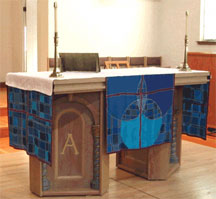 |
All of these photographs are of the communion table from the First Lutheran Church of Palo Alto, California. Here you can see one way that a church uses color to enhance worship in a particular time of the Christian year.
The upper left image is from Advent; the upper right image from Christmas. The middle left picture is of Ordinary time; the middle right from Lent. The lower left image is from Easter and the lower right from Pentecost Sunday. For the significance of the colors, see my last post. |
|
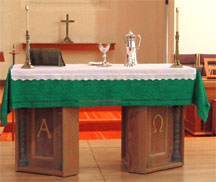 |
|
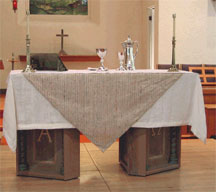 |
|
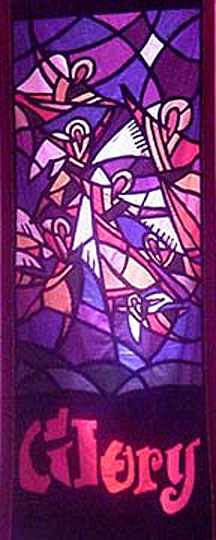 |
If your church does not have a communion table at the front, there are many other options for colorful art. Here are two banners that have been displayed in churches. The one on the left is an Advent banner, using the colors of this season (purple, violet, and pink). This banner is the creation of Jean Cross, a Christian artist who has made her work available to many churches. See her website.
The banner on the right is an Easter banner. It employs the dominant Easter colors, white, gold, and yellow, and also the celebrative shape of the Easter lily. |
|
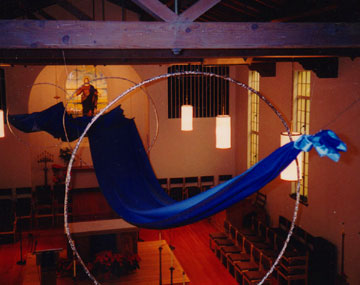 |
The last two images are both advent images. One the left a royal blue draping of material fills the worship space. One the right, the traditional purple candles of the Advent wreath glow tellingly. |
|
The Christian Year and the Textures of Worship
Part 4 of the series "How Lent Can Make a Difference"
Part 4 of the series “Advent and the Christian Year”
Posted at 10:00 p.m. on Sunday, December 5, 2004
In Part 3 of this series I explored the ways that liturgical colors can enrich our worship. In this post I want to pursue a bit further how the Christian year can enhance our worship and therefore our relationship with God.
As Christians we worship in light of the gospel. Our worship is a response to the God who has reached out to us in Jesus Christ, saving us from sin, death, isolation, and meaninglessness. Thus Christian worship is consistently infused with joy and gratitude. Moreover, since we worship the King of king and Lord of lords, we approach God humbly as well as boldly. And because God is glorious and majestic, our worship is filled with praise. At the core and in many of the details, Christian worship from day to day, from week to week, and from year to year, is essentially the same.
But this is not to say that our worship should be monotonous. In a given worship service we might focus on one particular aspect of God’s nature and therefore utilize distinctive expressions. For example, we might focus on the holiness of God, praising God’s perfection, thanking him for the gift of the Holy Spirit, and asking God to finish in us his work of sanctification (making us holy). Another week we might emphasize God’s grace, praising him for his forgiveness and seeking help to be gracious with one another. And so forth and so on. When our worship responds to the multifaceted character of God, and especially when it is shaped by the diversity of biblical revelation, it will have different textures and colors, even though the basic fabric is consistent from week to week.
The liturgical year contributes to the variety of our worship. Therefore it helps us to have a broader, deeper, and more vital relationship with God. It keeps us from the possibility of our worship becoming so routine that we cease to wonder at the grandeur of God. To put it bluntly, the variations of the Christian year help us not to become bored in worship.
Bored in worship? Is it possible? Logically speaking, this seems utterly impossible. If we remember that we worship the awesome Creator of the Universe, it’s hard to factor boredom into the worship equation. But sometimes, no matter how wonderful God is, and no matter how truthful our worship might be, if our expressions of worship are virtually the same from week to week, a kind of monotony can set in, and we can become – Heaven forbid! – bored. Perhaps you’ve had the experience of learning a new hymn or worship song and absolutely loving it. As you sing, your mind and heart are truly lifted before God. But, after you’ve sung the same song for the hundredth time, it loses some of its punch. Its tune is still memorable and its lyrics still full of truth, but its power to move your heart and stretch your mind has been diminished.
Worshipping in the same mode every week is a little like driving for a long distance through awesome mountains. When I first see the Rocky Mountains, for example, my heart explodes with joy and awe. These feelings continue for quite a while. But after I’ve driven among the Rockies for a day or more, I must confess that my appreciation begins to wane. I no longer remark on the stunning scenery, but begin to take it for granted. Of course the mountains themselves are still as majestic as ever. They haven’t changed or diminished, but my own sensibilities have become dull. I need refreshed vision so I can see the Rockies once again in their awesome beauty.
 |
If, however, my scenic menu were to be varied a bit, I’d be much less likely to become complacent in my admiration of the scenery. Last summer my family and I took a driving trip from Southern California, through the south-western desert, the rangelands of Utah, and the verdant forests of eastern Idaho. We drove through the varied terrain of Yellowstone National Park and alongside the majestic Grand Tetons. Then we returned by way of the stunning redness of Zion National Park. |
|
 |
 |
|
| In over two weeks of travel, I was never bored because my world kept changing. There were always new wonders to behold. |
| What I’ve just described is analogous to worshipping in light of the liturgical year. We begin in the rising plain of Advent, which leads us to the top of the celebrative pinnacle of Christmas. Then, after a month of travel through the fertile grasslands of “ordinary time,” we enter the parched desert of Lent in which our thirst for God is magnified. Holy Week guides us through the tortuous geography of Jesus’s last week, culminating in the dark cave of Holy Saturday. On Easter morning, the sun breaks forth with glorious light, and we are filled with awe as we gaze upon the towering mountain of God’s victory over death. Throughout the season of Eastertide the world seems brighter, more alive than ever before. At Pentecost we remember the our fellow travelers and refuel to continue on through the rolling hills of ordinary time, until we return to where we began at the start of Advent. |
|
|
I’ve known Christians who have been uncomfortable with certain aspects of the Christian year. They haven’t liked the waiting of Advent or the focus on our mortality in Lent. They want to live each day as if it were Easter. Now in a sense my friends are theologically correct. We should indeed live daily in light of the victory of God in Christ. But, speaking from my own experience, the less celebrative seasons of the church year (Lent, Advent) actually prepare me to experience greater vitality and rejoicing on the great feasts of Christian year, Christmas and Easter. Before I paid much attention to Lent and Holy Week, Easter zipped by without making a major dent in my consciousness. Now, as I keep the seasons of Lent and Holy Week, and as Easter has been stretched to include Eastertide, my joy over the resurrection has been multiplied several times over.
Once again I should emphasize that what I’ve been describing here is not a matter of biblical rule. You don’t have to recognize the Christian year to be a faithful follower of Jesus. But the experience of countless believers throughout the centuries should at least encourage you to consider shaping your yearly life by the themes and narratives of Scripture – and this is, after all, what the Christian year is really all about.
Lent: A Season of Preparation 
Part 5 of series: How Lent Can Make a Difference in Your Relationship with God 
Posted for Thursday, February 7, 2008
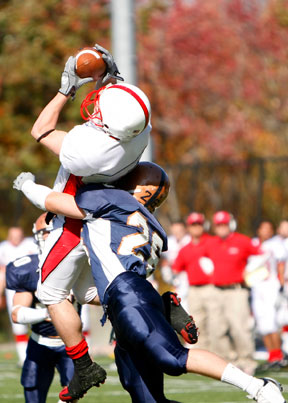 Well, we survived another Super Bowl. This year's game turned out to be an thrilling one, unless, of course, you're a New England Patriots' fan. Nevertheless, last Sunday evening we watched the culmination of years and years of training, as top athletes displayed their wares in the "big game." Win or lose, they can always say they played in the Super Bowl, which counts for a lot in American life today. Well, we survived another Super Bowl. This year's game turned out to be an thrilling one, unless, of course, you're a New England Patriots' fan. Nevertheless, last Sunday evening we watched the culmination of years and years of training, as top athletes displayed their wares in the "big game." Win or lose, they can always say they played in the Super Bowl, which counts for a lot in American life today.
So here's my question for you and me: Do we train for the things that matter most in life? Sometimes yes, sometimes no, I think. Most of us trained extensively for our professions, sometimes for multiple years after college. Yet, at the same time, most of us trained very little for parenting. These days, people often spend more time preparing for childbirth than for what to do afterwards. Similarly with matters of faith. I know some Christians who have prepared carefully for certain acts of discipleship, like going overseas as a missionary, for example. But others of us approach our faith rather like parenting, as something we can do just fine without much intentional preparation. Yet this, I would suggest, isn't a helpful approach to faith. I didn't make up this critique. It's inspired by the New Testament, specifically by Paul's first letter to Timothy:
Train yourself in godliness, for, while physical training is of some value, godliness is valuable in every way, holding promise for both the present life and the life to come. (1 Timothy 4:7-8)
(You might be interested to know that the verb "train" and the noun "training" in Greek are gymnazo and gymnasia, related to our word "gymnasium." You might be even more interested to know that these Greek words come from gymnos, which literally means "naked." Ancient Greek athletes trained and competed without clothing. But I digress . . . .) Scripture says: "Train yourself in godliness." Even as an athlete prepares for excellence in sport, so we should prepare for excellence in spiritual things.
There are lots of dimensions of spiritual preparation. Today I want to focus on one, and it's one that Paul didn't have in mind as he wrote to Timothy. Nevertheless, I think it reflects the basic intent of this Scripture passage.
I'm talking about Lent. Lent is a season of spiritual preparation. In days gone by, it was a time for new Christians to literally prepare for baptism and for joining the church. I know of some churches that continue this practice today. But, for most of us, Lent isn't about getting ready for baptism. Rather, it's about training our hearts for a deeper relationship with God. And, in particular, Lent is a time to prepare our spirits for the Super Bowl of the Christian year, Holy Week and Easter.
In the season of Lent, many Christians participate in a fast of some kind, setting aside certain foods or non-essential activities. Yet the point of the fast isn't deprivation so much as dedication of oneself to God. If I give up television for Lent, for example, I shouldn't replace it with extra hours playing video games. Rather, I should devote additional time to various spiritual disciplines, maybe even to good ol' fashioned rest.
Some Christian traditions emphasize, not so much giving up something in Lent as adding something. Here the focus is more directly on doing things that will help us draw near to the Lord: a Bible study at church, special service to the poor, reading C.S. Lewis, or . . . . But whether you give something up, or take something on, or both, the point is to help you draw near to God, so as to prepare your spirit to invest more deeply in the worship of Holy Week and Easter.
Lent is often a season of penitence, that is, a time when we remember our sins so that we might feel genuinely sorry for them and truly repent of them (turn away from them to God). Some Christians make a special effort to confess their sins each day of Lent. This is not about wallowing in guilt. Rather, it's a way to experience in a deeper way our need for God, and to receive His forgiveness more extensively.
No matter what you do or don't do in Lent, I would encourage you to let this be a season of preparation for Holy Week and Easter. (Technically, Holy Week is the culmination of Lent, which ends at midnight on Holy Saturday, the day before Easter.) The fruit of Lent is both a deeper relationship with God now and a more exuberant and mindful celebration of Easter in six weeks.
If you're not sure what to do in this Lenten season, let me once again suggest a simple Lenten discipline. Read one chapter of a gospel each day during Lent. Before you begin, ask the Lord to speak to you through his Word. Read slowly and prayerfully. Let the text sink into your mind and heart. When you've finished reading, pray about whatever has touched you. If you begin with the Gospel of Mark, you'll have enough time to read it and one other gospel during Lent.
May the Lord bless you in this season of Lenten preparation!
Reflections on Fasting in Lent 
Part 6 in the series: How Lent Can Make a Difference in Your Relationship with God
Posted for Friday, February 8, 2008
(Edited and expanded version of a post from last year)
I grew up hearing about Catholics fasting during the season of Lent. No meat on Fridays, only fish, which in my school cafeteria was something to be avoided at all costs. This always seemed to me to be one more good reason to be a Protestant. But, in the past fifteen years or so, I've sometimes decided to join my Catholic sisters and brothers in giving up something during the 40 days (46, including the Sundays) prior to Easter.
People in my theological tradition (the Reformed tradition, pioneered by John Calvin) tend not to emphasize Lenten fasting. Partly this had to do with the conscious rejection of Roman Catholic practices that were not clearly based on Scripture. Many Reformed folk, and other Protestants, chose instead to add some spiritual discipline to their lives as a way of preparing for Easter. It's quite common today for churches that don't have midweek Bible studies, for example, to offer a Lenten Wednesday Evening Study or something like this. Special Lenten spiritual retreats are also increasingly common in Protestant and Roman Catholic circles.
Throughout church history there have been different kinds of Lenten fasts. Nobody, to my knowledge, expected anyone to give up all food for the whole season. In the Middle Ages it was common for Christians to give up certain sorts of food, like meat and/or dairy products, for example. Many Catholics still refrain from eating meat on the Fridays of Lent. In the Eastern Orthodox Church, the Lenten fast is taken even more seriously than in the Roman Catholic church, with many Orthodox folk eating vegetarian meals during the season.
 During the past fifteen years I have sometimes given up something in Lent, perhaps chocolate or watching television. The latter was particularly hard because I enjoy college basketball, and March Madness (the NCAA bastketball tournament) always falls in the middle of Lent. This year I decided to give up something I enjoy. It don't think it would be appropriate for me to speak in detail about what I'm doing at this time. But I would like to share some reflections on what I'm learning by my version of a Lenten fast. During the past fifteen years I have sometimes given up something in Lent, perhaps chocolate or watching television. The latter was particularly hard because I enjoy college basketball, and March Madness (the NCAA bastketball tournament) always falls in the middle of Lent. This year I decided to give up something I enjoy. It don't think it would be appropriate for me to speak in detail about what I'm doing at this time. But I would like to share some reflections on what I'm learning by my version of a Lenten fast.
First, giving up something allows me to make a tangible sacrifice to the Lord. Although certain sacrifices are already present in my life, I don't often experience giving up something for God on a daily basis. The act of sacrifice reminds me of my commitment to God and my desire to make Him first in my life.
Second, by giving up something I usually enjoy on a daily basis, I have sometimes found myself yearning for that thing. Frankly, I've been tempted to give up my Lenten fast at times. I could easily argue that it's unnecessary (it is optional, after all) and certainly not taught in Scripture. But, though I don't think my effort at fasting makes God love or bless me more, I do think it raises my awareness of how much I depend on other things in life rather than the Lord. I see how easy it is for me to set up all sorts of little idols in my life. Fasting, in some way, helps me to surrender my idols to God.
Third, when I give up something I like and then feel an unquenched desire for it, I'm reminded of my neediness as a person. And neediness, I believe, is at the heart of true spirituality. Jesus said:
"Blessed are the poor in spirit, for theirs is the kingdom of heaven. . . .
Blessed are those who hunger and thirst for righteousness, for they will be filled."
Matthew 5:3, 6
Of course feeling hungry for one of life's pleasures isn't quite the same as hungering and thirsting for righteousness. But when I feel my hunger, when I sense my neediness for some other thing, I can use this to get in touch with my hunger and need for God.
Fourth, as I continue with my Lenten fast, I find myself less eager for the thing I've given up. Ironically, this makes my fast easier. It's almost something I can take for granted, thus dulling the spiritual impact of the fast. But I'm also gratified to know that one of my little "idols" is being set aside in my heart, as I learn to depend more upon God. I'm experiencing a bit of freedom that makes me gladly thankful for God's grace at work in me.
So, as we enter the season of Lent, I am grateful for the saints who have gone before me, who discovered the blessings of giving up something in Lent. I pray that God will use this season to draw me closer to Him, and to prepare me for a fresh experience of Good Friday and Easter. May God's peace be with You! |

